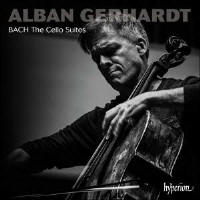Texte paru dans: / Appeared in: |
|
|
Reviewer: Jerry
Dubins Two virtually parallel releases of Bach’s Solo Cello Suites performed by two leading cellists—one, Jiří Bárta, using a circa 1700 Baroque cello by an anonymous Prague maker; the other, Alban Gerhardt, using an unnamed modern cello, or, at least one that has been retrofitted to modern standards—and a pretty conspicuous timing difference of 14 minutes between them. What could account for the difference? Two possibilities come to mind: 1) Bárta’s tempos in a preponderance of movements are considerably slower; 2) Gerhardt skips some or all of the repeats. Which is it, or is there some other factor I’ve overlooked?
Well, it turns out that it’s not an either/or situation. Bárta and Gerhardt both take the repeats, so that’s not the answer. One hundred percent (or close to it) of the differences in movement timings can be attributed to the simple fact that Bárta plays at torpid tempos that would make a tortoise’s torpor seem expeditious, while Gerhardt races through the suites at speeds that render the preludes perfunctory, the courantes cursory, the sarabandes superficial, and the gavottes glib. He skips half of the written trills, and largely ignores the slurs in measures of slurred 16th notes, preferring to take separate bows on each note, which not only turns his articulation choppy, but in some cases negates Bach’s deliberate displacing of rhythmic accents by slurring groups of notes in unusual ways, for example in a 6/8 bar containing two groups of 16th notes, slurring the first seven and then the remaining five.
In an unexpected reversal of what is often the norm, Bárta’s Baroque cello produces a fine-grained, lovely tone in an open acoustic setting, while Gerhardt’s modern cello, captured closer up and in a less flattering acoustic, sounds hard-edged and raspy.
One further bizarre consequence of Bárta’s slow tempos is that it put Animal Music’s engineers on the “what-to-do” spot. No matter how they sliced, spliced, or diced it, they had to split one of the suites between the two discs because the normal layout of Suites 1, 2, and 3 on disc 1, and Suites 4, 5, and 6 on disc 2 would have exceeded the capacity of disc 2. So, the only solution was to peel off the first two movements of the Fourth Suite from disc 2 and paste them on to the end of disc 1, requiring the listener to change discs after the Allemande of the Suite No. 4. I don’t know if this could have been avoided by resequencing the order of the suites on the discs, but you can blame Bárta’s tempos for this unfortunate outcome.
In my opinion, neither of these efforts merits a recommendation. I say fie on both of them. Many versions of Bach’s Cello Suites, a number of them well received, have passed this way since 31:4, yet none has so far nudged Jean-Guihen Queyras out of the running as my first choice. For Bach’s Cello Suites, I’d look elsewhere than to these two latest efforts. | |
|
|
|
|
|
|
|
Cliquez l'un ou l'autre
bouton pour découvrir bien d'autres critiques de CD |
|





